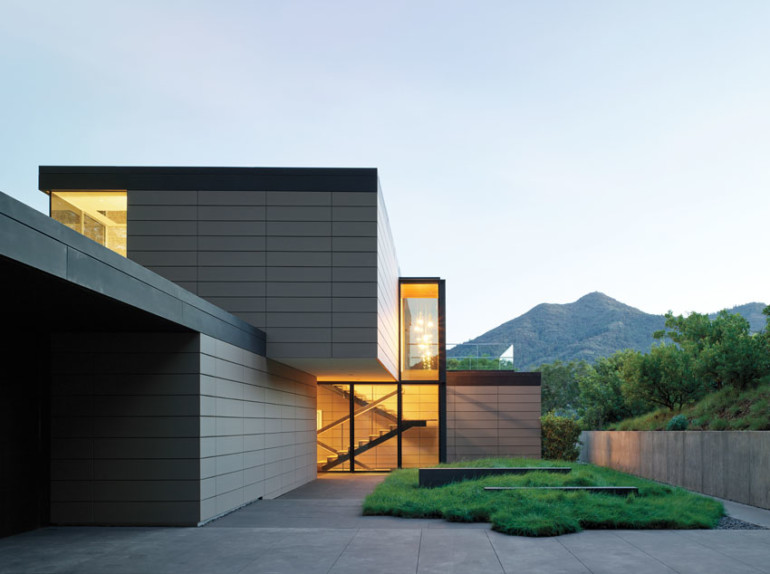PERHAPS THE GREATEST HURDLE of building on a hilltop where the towns of Ross and Kentfield share a territorial border was that a woodsy midcentury summer home by noted architect William Wurster already stood there.
Its historic value was hotly debated, but because of clumsy additions and other changes made to it over the years, both cities eventually allowed a new house by the Los Angeles and San Francisco firm Ehrlich Yanai Rhee Chaney Architects to take its place.
Completed about a year ago, the 7,500-square-foot home, designed collaboratively by principal architects Steven Ehrlich and Takashi Yanai, has nearly the same-size footprint as its predecessor. Nestled amid an acre and a half of redwoods and sun-loving live oak forests that thrive in that ecotone, the new house also takes full advantage of a wide panorama, crowned by the county’s emblematic peak, Mount Tamalpais.
Composed of four rectilinear volumes laid in a roughly reverse Z-shaped plan and stacked on three floors, the house has discrete public and private open-plan areas that flow easily from one into the other to accommodate the owner, an audiovisual systems specialist who often works from home.
The building’s rigorous right-angled geometry allows him “a variety of indoor-outdoor experiences,” says Yanai, who admired such layouts when he was an architecture magazine editor in his native Japan.
Because of its floor plan, nearly all the rooms have access to stone-covered courtyards and wood decks interspersed with Zen-like gardens planted by the San Francisco landscape architecture firm Surfacedesign Inc.
To establish other subliminal links to nature, the building exterior features German-made terra-cotta panels that match the color of redwood bark and all-weather Rheinzink roof fasciae. And large slim-line aluminum-and-glass doors and windows by Vitrocsa literally reflect the surrounding woods.
A dramatic glass-walled stairwell, visible from the entry court, links the building’s top floor to the ground floor and a state-of-the-art screening room in the basement. Figures walking up or down the stairs animate the sculptural tower, which illustrates a Japanese concept called ma. Loosely translated, “ma is a desirable empty space, a gap or an interval between forms, sounds or emotions,” Yanai says.
On the ground floor, even though the nine-foot-high solid wood and blackened steel front door seems impenetrable, rooms inside seem to have only invisible boundaries, suggested largely by the materials that cover floors or walls.
For instance, the kitchen/dining area’s polished concrete floors abut black American walnut wood floors in the adjacent sunken living room, and its boards in turn line up perfectly with a teak deck just outside sliding glass doors.
The owner’s casual lifestyle obviated a formal dining room, so the custom kitchen by New York–based Minimal has an easy-to-clean back-painted glass backsplash, dark wenge wood cabinets, and a wood dining counter that springs off the Corian kitchen island. Its bar stools are comfortable enough for dinner parties — at the chef ’s table, as it were — as well as for the owner to sometimes do his work there, facing the south lawn and mountain views.
“When this room’s glass doors are pushed open, the dining counter feels just like a picnic table,” the owner says.
On the top floor, above the living area, the cantilevered master suite has wall-size windows on three sides, facing views. Opposing doors on the east and west walls open onto teak terraces. In sync with Northern California’s preference for natural building materials, a large walk-in closet and dressing area at the north end of the room are wood lined, and the master bathroom looks onto a gravel-covered roof deck.
A separate one-story pavilion on the northeast side of the main building contains a home office, gym and sauna. Its flat roof cantilevers westward to meet the main house at a right angle, forming a breezeway between the conjoined buildings. The L-shaped wing also shelters a dark basalt-and-concrete tile courtyard with unhampered views of the San Francisco Bay and the East Bay hills. The courtyard abuts the living room deck as well as a highly reflective black tile swimming pool perched on the east slope. A square infinity-edge plunge pool in the middle of the courtyard also mirrors the sky. In this stylized Japan-inspired setting that “borrows” elements of the landscape, a long rectangular gas fire pit next to the larger pool adds a ceremonial finishing touch.
Part retreat and part home office, the house is also a showcase for the owner’s growing collection of modern furnishings, art photography and cars. The three-car garage, painted black inside, is like a theater that can be viewed through a large “proscenium” window cut into the wall of a corridor that separates the garage from guest rooms.
“Even my Mini Cooper looks like a million dollars in that garage,” the owner says with a chuckle.
Despite such deliberately jazzy features, the house does settle into its wooded site comfortably, thanks to its material and color palettes. Several corridors within the structure offer long telescopic views through windows placed strategically at the ends, and from his vantage point high above the center of Ross, the owner can also toast the summer fog that quietly floats past Mount Tamalpais and edges the valley below.
“This landscape is very powerful and calming at the same time,” Yanai says. “We have just tried to honor it and frame the view.”
[gtx_gallery]
Resources
ARCHITECT Ehrlich Yanai Rhee Chaney Architects, eyrc.com, principal architects Steven Ehrlich and Takashi Yanai
LANDSCAPE DESIGN SurfaceDesign, sdisf.com
LIGHTING DESIGNER PritchardPeck Lighting
LIVING ROOM Sofa set, Minotti, minotti.com/en; speaker tower, KEF blades, us.kef.com
KITCHEN Kitchen cabinets/dining counter, Minimal Kitchen, minimalusa.com
DINING ROOM Dining stools, Minotti; hanging lights, Stone Lighting, stonelighting.net
BATHROOM Faucets, Boffi, boffi.com
BEDROOM Chair, Knoll Eero Saarinen Womb Chair, knoll.com
This article originally appeared in Spaces’s print edition under the headline: “Frame of Mind”.


